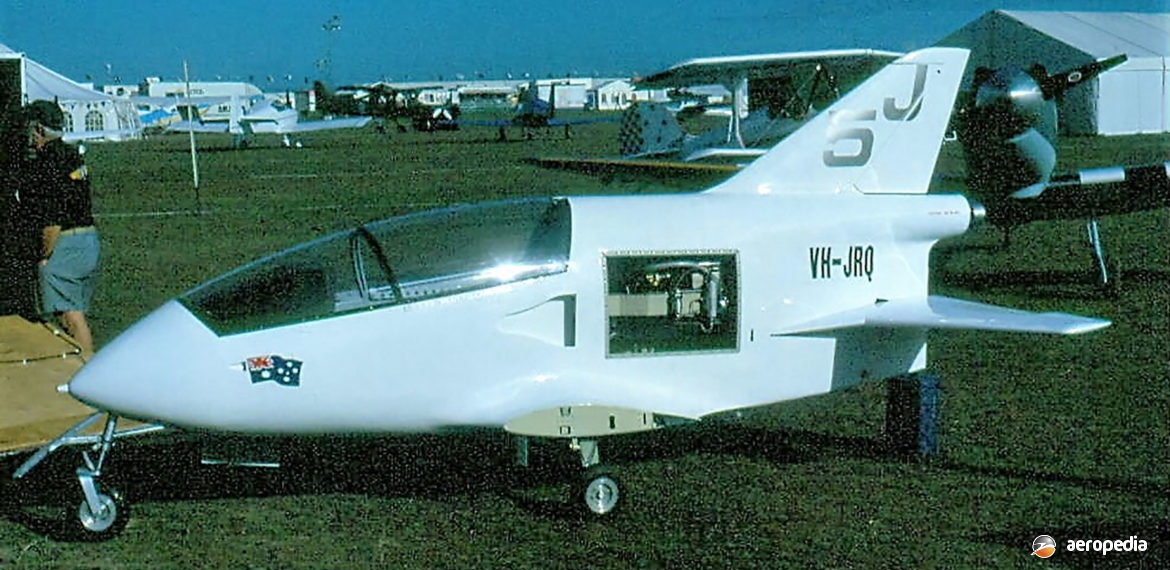Photograph:
A Bede BD-5J Jet VH-JRQ (c/n BDA-01) on display at the Australian International Airshow at Avalon, VIC (David C Eyre)
Country of origin:
United States of America
Description:
Single-seat light sport jet aircraft
Power Plant:
One 220 lbst Micro Turbo TRS-18 Cougar turbojet
Specifications:
- Wingspan: 5.18 m (17 ft)
- Length: 4.05 m (13 ft 3 in)
- Max speed at sea level: 531 km/h (330 mph)
- Cruising speed at 2,286 m (7,500 ft): (320 mph)
- Stalling speed clean: 130 km/h (81 mph)
- Stalling speed with flaps: 114 km/h (71 mph)
- Cruising range: 885 km ( 550 miles)
- Rate of climb: 732 m/min (2,400 ft/min)
- Take-off roll: 335 m (1,100 ft)
- Landing roll: 244 m (800 ft)
- Empty weight: 193 kg (425 lb)
- Loaded weight: 413 kg (910 lb)
History:
By late 1971 Bede Aircraft claimed it had 4,300 orders for the BD-5 series but found changes had to be made to the design as flight testing revealed the V-tail was unstable. The changes included a change from fibreglass construction to all aluminium, and at that time the Hirth engine of 650 cc providing 41 kw (55 hp) was chosen as the piston-engine for the type. However, Hirth went into liquidation and that engine became unavailable.
BD Micro Technologies of Siletz, Oregon, USA was then formed to assist those who had received projects and this Company commenced production of up-dated kits and provided owners with assistance during construction. Further development continued and in the 1990s turbine powered and a turbojet powered variants were produced. The latter became known as the BD-5J Microjet and at least one example was built in this part of the world. Fitted with a 200 lbst turbojet, this model achieved a max speed of 467 km/h (290 mph) and a cruising speed of 386 km/h (240 mph) with a gross weight of 390 kg (860 lb).
First of the type seen in this region was N53EJ demonstrated at the Australian International Airshow at Avalon, VIC in March 1995, this aircraft being imported from the United States specifically for the show, being shipped back after a few weeks. One appeared in 1983 in the James Bond movie ‘Octopussy’ starring Roger Moore, the aircraft described as a BD-5J ‘Acrostar’ jet being flown by Corkey Fornof.
Two examples flew at a number of air shows in the United States in the 1970s, being known as the Sonic Acrojets. They were said to be the tiniest two-aircraft air show act of all, and were the world’s smallest jet-powered aircraft. The aircraft were sponsored by Sonic Industries, which operated a chain of drive-in restaurants and proclaimed, as its slogan, ‘Service at the Speed of Sound’. Pilots were JW Corkey Fornof and RG Bob Bishop. The pilots built their own aircraft and they were known as Acrojet Specials rather than BD-5Js as they were said to be highly refined variants of the design. Inverted flying was restricted to 20 seconds due to oil-pressure limitations of the engine and cruising at 3,658 m (12,000 ft) they had an endurance of one hour at 402 km/h (250 mph). They performed aerobatics in close formation, including opposition knife-edge passes and individual 16 point slow rolls.
First BD-5J registered in Australia was VH-JRQ (c/n BDA-01) in early 1999, this aircraft being completed by Quentin Campbell of Kambah, ACT. It was conveyed to and placed on display at the Australian International Airshow at Avalon in 1999. It took Mr Campbell about four years to build. It was constructed predominantly from raw materials, the builder stating very few kit parts were used as the availability of kits in Australia at the time was not good. It was powered by a Micro Turbo 022 Cougar jet engine which provided 200 lb thrust. It is not known to have flown in Australia and a couple of years later it was exported to the United States to a pilot in Forth Worth, Texas.

